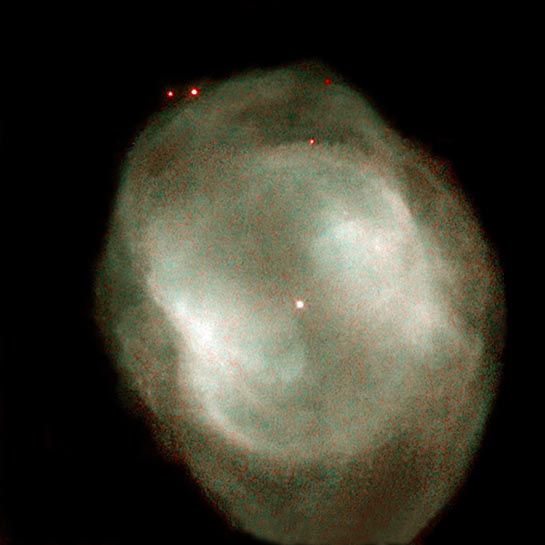
Planetary nebula
RA 10h 9m 21.16s Dec -80° 51' 28.54"
Chamaeleon
5500 light-years
11.6
40 x 35 arcsec
0.89 x 0.87 arcminutes
North is 6.2° left of vertical
Howard Bond (STScI) and NASA/ESA
December 17, 1997
ABOUT
THIS IMAGE:
This image is a part of the Hubble Gallery of Planetary Nebulae.
From Wikipedia:
NGC 3195 is a planetary nebula located in the constellation Chamaeleon. It is the most southern of all the bright sizable planetary nebula in the sky, and remains invisible to all northern observers. Discovered by Sir John Herschel in 1835, this 11.6 apparent magnitude planetary nebula is slightly oval in shape, with dimensions of 40×35 arc seconds, and can be seen visually in telescopic apertures of 10.5 centimeters (4.1 in) at low magnifications.
Spectroscopy reveals that NGC 3195 is approaching Earth at 17 kilometers per second (11 mi/s), while the nebulosity is expanding at around 40 kilometers per second (25 mi/s). The central star is listed as >15.3V or 16.1B magnitude. Distance is estimated at about 1.7 kpc.
From NASA:
The final item in the Caldwell catalog, Caldwell 109 resembles a phantom snowball. The glowing shroud of gas was shed by its central star in a final act before dying. Like all stars, the one in the middle of this nebula spent its life participating in a precarious balance act, with the outward pressure generated by nuclear fusion countered by the inward pull of gravity. During most of the star's lifetime the two held an uneasy truce, making the star a giant, controlled nuclear bomb.
When the star began to exhaust its hydrogen fuel, however, there wasn't enough pressure to fight off gravity. The core began to contract, becoming denser and hotter, triggering the fusion of helium into carbon. The heat produced caused the star's outer layers of gas to expand, transforming the star into a red giant. After spending about a billion years as a red giant, the star began a 10,000-year process to shed its outer layers of gas, ultimately uncovering the remaining core of the star - a white dwarf. High-energy radiation from the white dwarf makes the cast-off gaseous layers glow, creating a ghostly specter in the night sky. In tens of thousands of years, Caldwell 109 will fade into darkness as the white dwarf cools like an ember until it finally burns out completely.
Planetary nebulas like Caldwell 109 are especially interesting to scientists because they represent a future stage of our own Sun, which is destined to meet a similar fate in about 6 billion years. This Hubble image was taken in visible and infrared light using the Wide Field and Planetary Camera 2 as part of a survey of planetary nebulas. The observations revealed many surprisingly intricate, glowing patterns spun into space by aging stars: pinwheels, lawn-sprinkler-style jets, elegant goblet shapes and even some that look like a rocket engine's exhaust.
Caldwell
109 was discovered by John Herschel in 1835 and subsequently cataloged
as NGC 3195. It lies 5,500 light-years away toward the Chamaeleon constellation.
It is visible year-round from the Southern Hemisphere but is highest in
the autumn. With a magnitude of 11.6 it can be a challenging target to
spot for small telescopes. Through a moderate-sized telescope, Caldwell
109 will look like a swollen star.